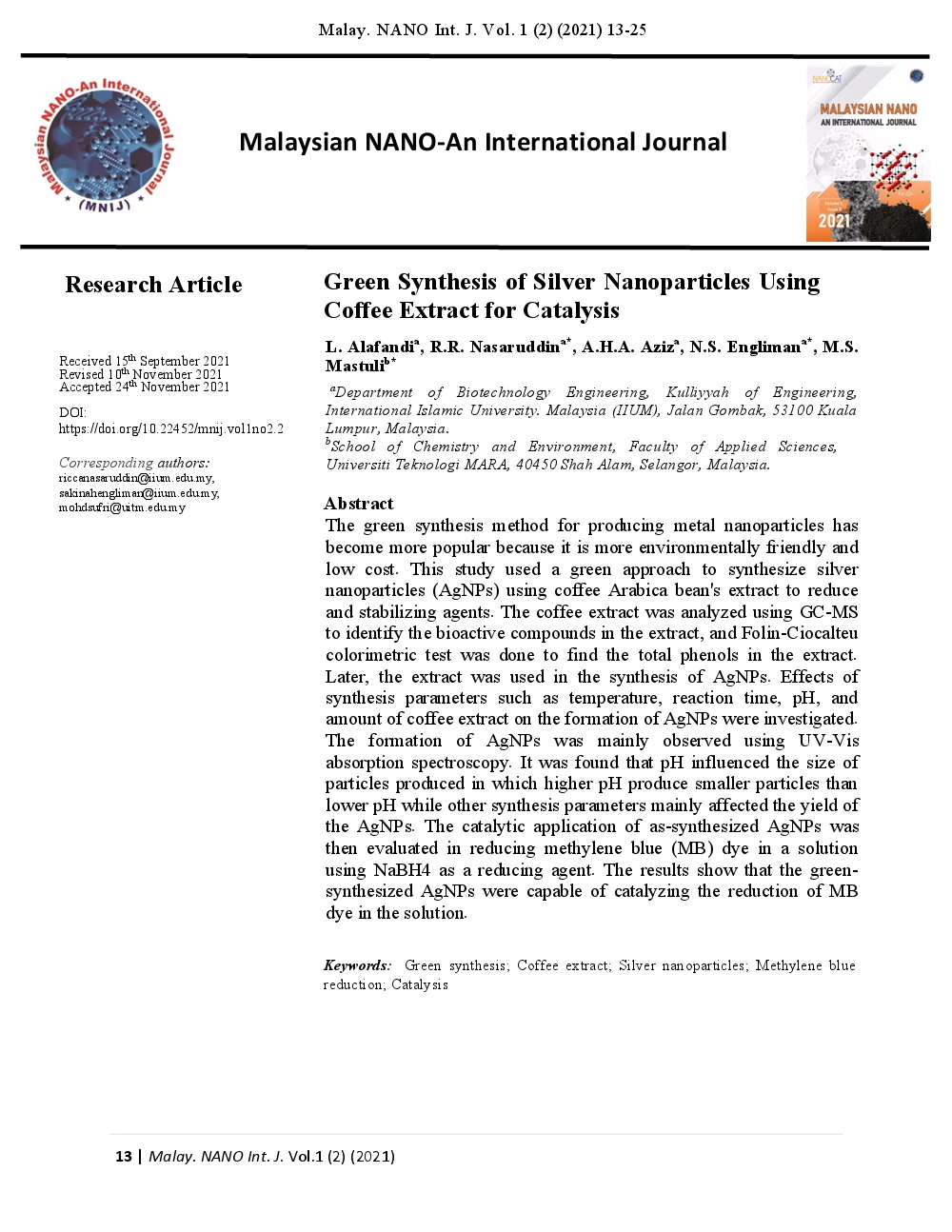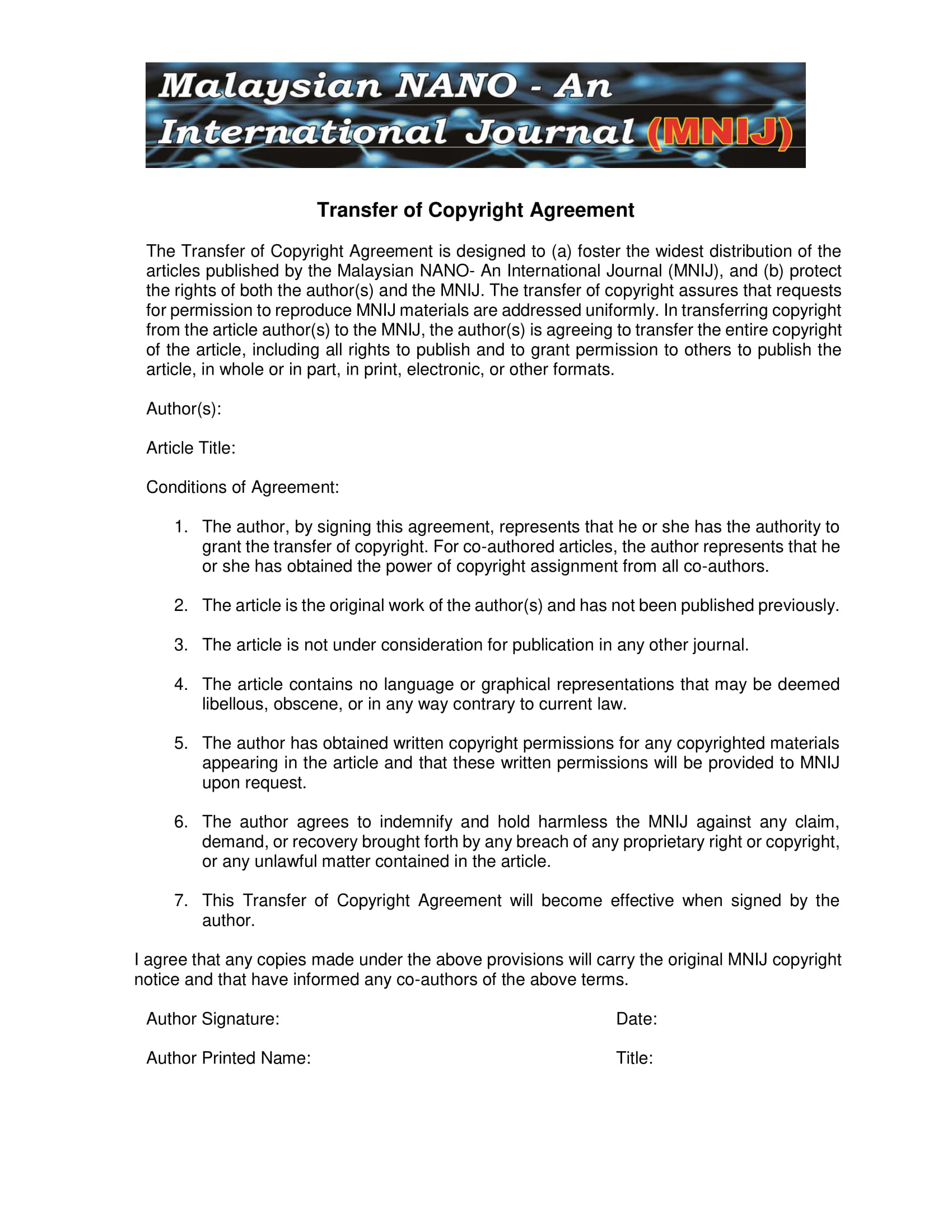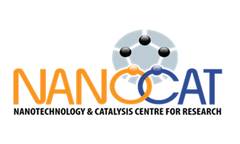Green synthesis of silver nanoparticles using coffee extract for catalysis
DOI:
https://doi.org/10.22452/mnij.vol1no2.2Keywords:
Green synthesis , Coffee extract, Silver nanoparticles, Methylene blue reduction, CatalysisAbstract
The green synthesis method for producing metal nanoparticles has become more popular because it is more environmentally friendly and low cost. This study used a green approach to synthesize silver nanoparticles (AgNPs) using coffee Arabica bean's extract to reduce and stabilizing agents. The coffee extract was analyzed using GC-MS to identify the bioactive compounds in the extract, and Folin-Ciocalteu colorimetric test was done to find the total phenols in the extract. Later, the extract was used in the synthesis of AgNPs. Effects of synthesis parameters such as temperature, reaction time, pH, and amount of coffee extract on the formation of AgNPs were investigated. The formation of AgNPs was mainly observed using UV-Vis absorption spectroscopy. It was found that pH influenced the size of particles produced in which higher pH produce smaller particles than lower pH while other synthesis parameters mainly affected the yield of the AgNPs. The catalytic application of as-synthesized AgNPs was then evaluated in reducing methylene blue (MB) dye in a solution using NaBH4 as a reducing agent. The results show that the green-synthesized AgNPs were capable of catalyzing the reduction of MB dye in the solution.
Downloads
References
G. Benelli. Green synthesis of nanomaterials. Nanomaterials. 2019: 9: 9.
S. M. Mousavi et al. Green synthesis of silver nanoparticles toward bio and medical applications: review study Artif. Cells. Nanomedicine Biotechnol. 2018: 46; 3; S855–S872.
H. C. Erythropel et al. The Green ChemisTREE: 20 years after taking root with the 12 principles. Green Chem. 2018: 20: 9: 1929–1961.
X. F. Zhang, Z. G. Liu, W. Shen, and S. Gurunathan. Silver nanoparticles: Synthesis, characterization, properties, applications, and therapeutic approaches. Int. J. Mol. Sci. 2016: 17; 9. [5] R. R. Nasaruddin, T. Chen, Q. Yao, S. Zang, and J. Xie. Toward greener synthesis of gold nanomaterials: From biological to biomimetic synthesis. Coord. Chem. Rev. 2021: 426; 213540. [6] M. Baghaienezhad, M. Boroghani, and R. Anabestani. Solver nanoparticles synthesis by coffee residues extract and their anti-bacterial activity. Nanomed. Res. J. 5: 29 - 34.
H. P. Borase et al. Plant extract: A promising biomatrix for eco-friendly, controlled synthesis of silver nanoparticles. Appl. Biochem. Biotechnol. 2014: 173; 1; 1-29.
G. R. Genwali, P. P. Acharya, and M. Rajbhandari. Isolation of Gallic Acid and Estimation of Total Phenolic Content in Some Medicinal Plants and Their Antioxidant Activity. Nepal J. Sci. Technol. 2013: 14;1; 95–102.
M.S. Latif, S. Abbas, F. Kormin and M.K. Mustafa. Green Synthesis of Plant-Mediated Metal Nanoparticles: The Role of Polyphenols. Asian J. Pharm. Clin. Res.v2020. 2019: 75–84.
A. Halder, S. Das, T. Bera, and A. Mukherjee. Rapid synthesis for monodispersed gold nanoparticles in kaempferol and anti-leishmanial efficacy against wild and drug-resistant strains. RSC Adv. 2017: 7;23; 14159–14167.
S. S. Dash and B. G. Bag. Synthesis of gold nanoparticles using renewable Punica granatum juice and study of its catalytic activity. Appl. Nanosci. 2014: 4;1; 55–59.
S. Rajeshkumar, L. V. Bharath, and R. Geetha. Broad spectrum anti-bacterial silver nanoparticle green synthesis. Characterization, and mechanism of action. Elsevier Inc. 2019.
A. K. Biswal and P. K. Misra. Biosynthesis and characterization of silver nanoparticles for prospective application in food packaging and biomedical fields. Mater. Chem. Phys. 2020: 250; 123014.
J. Y. Song and B. S. Kim. Rapid biological synthesis of silver nanoparticles using plant leaf extracts. Bioprocess Biosyst. Eng. 2009: 32;1; 79–84.
A. Gade, S. Gaikwad, N. Duran, and M. Rai. Green synthesis of silver nanoparticles by Phoma glomerata. Micron. 2014: 59: 52–59.
N. L. Gavade, A. N. Kadam, M. B. Suwarnkar, V. P. Ghodake, and K. M. Garadkar,. Biogenic synthesis of multi-applicative silver nanoparticles by using Ziziphus Jujuba leaf extract. Spectrochim. Acta - Part A Mol. Biomol. Spectrosc. 2015: 136; PB; vol. 136, no. PB; 953– 960.
S. U. Ganaie, T. Abbasi, and S. A. Abbasi. Green synthesis of silver nanoparticles using an otherwise worthless weed mimosa (Mimosa pudica): Feasibility and process development toward shape/size control. Part. Sci. Technol. 2015: 33;6; 638–644.
S. Iravani and B. Zolfaghari. Green synthesis of silver nanoparticles using Pinus eldarica bark extract. Biomed Res. Int. 2013.
W. H. Eisa, M. F. Zayed, B. Anis, L. M. Abbas, S. S. M. Ali, and A. M. Mostafa. Clean production of powdery silver nanoparticles using Zingiber officinale: The structural and catalytic properties. J. Clean. Prod. 2019: 241.
R. M. Tripathi, N. Kumar, A. Shrivastav, P. Singh, and B. R. Shrivastav. Catalytic activity of biogenic silver nanoparticles synthesized by Ficus panda leaf extract. J. Mol. Catal. B Enzym. 2017: 96; 75–80.
V. K. Vidhu and D. Philip. Catalytic degradation of organic dyes using biosynthesized silver nanoparticles. Micron. 2014; 56; 54–62.

Downloads
Published
How to Cite
Issue
Section
License





